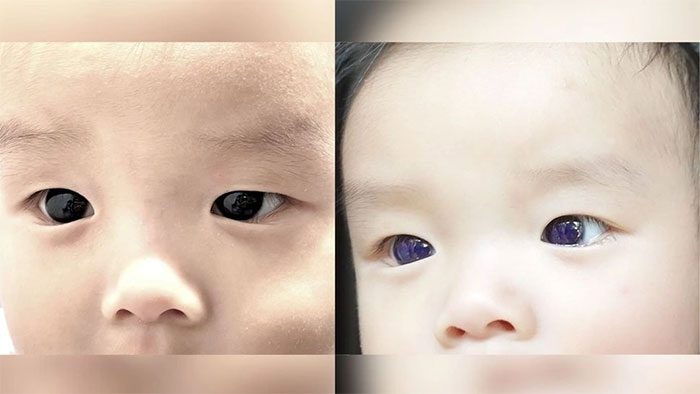A 6-Month-Old Boy’s Brown Eyes Turned Dark Blue After Taking Antiviral Medication for Covid-19.
This case is certainly unusual, but this is not the first time doctors have reported a patient experiencing a change in eye color after using Covid-19 medication Favipiravir. So, what causes this strange transformation?

Normally, the baby has brown eyes (left image) and turns to blue eyes (right image) after being treated with antiviral medication. (Image: Jiravisitkul et al. 2023, DOI: 10.3389/fped.2023.1154814. CC BY 4.0).
First, let’s explore a bit about Favipiravir. This antiviral drug is used to target various types of viruses, including the influenza virus and the Ebola virus.
This medication works by blocking viruses from replicating their genetic material. It is particularly effective against viruses that use RNA as their genetic material. When viruses create RNA copies of themselves, the drug inserts itself into the developing RNA molecules, causing mutations.
In early 2020, this drug was approved for use in China to treat Covid-19. Since then, several other countries, including India, Japan, and Thailand, have also permitted the use of this medication for treating mild to severe Covid-19 cases. In Thailand, this drug is the primary medication used for children with Covid-19.
Common side effects of Favipiravir include diarrhea, reduced white blood cell count, and elevated uric acid levels in the blood, which if untreated, can lead to nausea and kidney stones. But what about the reports of eye color changing to blue?
This unwanted effect was first noted in December 2021 when a 20-year-old with brown eyes experienced a shift to blue eyes after just one day of taking Favipiravir.
However, in the summer of 2020, another group of doctors reported a case of a male patient whose eyes exhibited a fluorescent hue after using this medication. In 2022, three cases were also recorded where fluorescent spots appeared in the sclera of the eyes, on fingernails and teeth after using Favipiravir.
Most recently, doctors reported the case of a 6-month-old boy whose eye color changed. According to a report published in the journal Frontiers in Pediatrics, the boy was taken to a hospital in Thailand after family members noticed he was coughing and had a fever. Tests revealed he was infected with Covid-19, and doctors prescribed Favipiravir in both pill and syrup form.
Just 18 hours after taking the medication, the mother noticed her child’s eye color changed from brown to blue. Upon closer examination, doctors found blue pigment accumulating in the boy’s cornea.
After the boy took Favipiravir for three days, the doctors decided to stop the medication when they saw the eye color change. Five days after discontinuing the drug, the boy’s eye color returned to normal.
Dr. Vik Sharma, an eye surgeon at LondonOC Hospital in the UK, who did not participate in the boy’s treatment, noted that “normally, eye color is determined by the iris, not the cornea, and is influenced by the amount of pigment present in the iris at birth.”
However, the blue tint caused by Favipiravir stems from how each individual’s body processes this medication. When the drug is metabolized, it may release fluorescent chemicals that can accumulate in the cornea, Dr. Sharma explained. In some individuals, this fluorescent substance accumulates in hair and nails.
In the case of the aforementioned boy, doctors reported that the fluorescence could be attributed to the drug, its metabolites, or supplementary components of the medication such as titanium dioxide and yellow iron oxide. The medication prescribed for the boy was tested with UV light in the lab and was found to emit fluorescent light.
Two weeks after recovering from Covid-19, the boy was examined by an ophthalmologist who concluded there were no longer signs of eye color change in either of the boy’s eyes. However, it remains unclear whether the boy may experience further eye color changes in the future, as noted in his medical record.
Dr. Sharma stated that “more research is needed to determine the exact cause of the eye color change and any potential long-term side effects.”
Factors such as age, duration of treatment, and dosage of the medication can influence the unusual progression of these rare side effects and the duration of the eye color change before returning to normal.
However, because this strange effect has only occurred in a few individuals, it is still unclear why or how Favipiravir causes eye color changes in a select few, while the majority remain unaffected.


















































